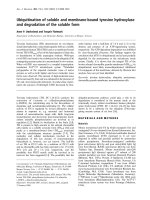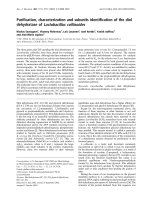Báo cáo y học: "Insulin, intracerebral glucose and bedside biochemical monitoring utilizing microdialys" pdf
Bạn đang xem bản rút gọn của tài liệu. Xem và tải ngay bản đầy đủ của tài liệu tại đây (107.95 KB, 3 trang )
Page 1 of 3
(page number not for citation purposes)
Available online />Abstract
Following subarachnoid hemorrhage, hyperglycemia is strongly
associated with complications and with impaired neurological
recovery. Targeted insulin therapy for glycemic control might, on
the contrary, have harmful effects by causing too low cerebral
glucose levels. The study published by Schlenk and colleagues in
the previous issue of Critical Care shows that insulin caused a
significant decrease in the interstitial cerebral glucose concen-
tration although the blood glucose level remained unaffected.
Since several studies utilizing various analytical techniques have
shown that cerebral blood flow and cerebral glucose uptake and
metabolism are insulin-independent processes, the observation
remains unexplained.
The study published by Schlenk and colleagues in the
previous issue of Critical Care was initiated by clinical
experience that, after subarachnoid hemorrhage, hyperglycemia
is strongly associated with complications and impaired
neurological recovery. Utilizing intracerebral microdialysis and
bedside biochemical monitoring, Schlenk and colleagues
made the unexpected observation that insulin caused a
significant decrease in the interstitial cerebral glucose
concentration although the blood glucose level remained
unaffected [1].
The technique of microdialysis was introduced more than 30
years ago for monitoring the animal brain, and has become a
standard technique in neuroscience with well over 11,000
publications [2,3]. Microdialysis was introduced as a routine
technique within neurointensive care in 1995. The chemical
variables generally analyzed and displayed at the bedside are
those related to glycolysis (glucose, pyruvate, lactate) as well
as those of glycerol and glutamate. A simplified diagram of
intermediary metabolism is shown in Figure 1. The figure also
shows data for these chemical variables in the normal human
brain during wakefulness [4].
Since glucose is the main – or sole – substrate for cerebral
energy metabolism under normal conditions, the possibility of
measuring the glucose interstitial concentration is of obvious
clinical interest. The calculated lactate/pyruvate ratio
indicates the cytoplasmatic redox state, which reflects tissue
oxygenation and the efficacy of oxidative metabolism. The
ratio can be expressed in terms of the lactate dehydrogenase
equilibrium: [NADH] [H
+
] / [NAD
+
] = [lactate] / [pyruvate] x
K
LDH
.
As indicated in Figure 1, glycerol is related to intermediary
energy metabolism. The glycerol level will accordingly vary
with the cerebral metabolic rate [4]. The changes in the
glycerol concentration caused by variations in the glycolytic
rate are limited, however, and a marked increase in the
cerebral glycerol level indicates degradation of the glycero-
phospholipids of the cell membranes [5]. The glutamate
obtained by microdialysis of the cerebral interstitial space
does not necessarily represent the excitatory transmitter.
Since the reuptake of extracellular glutamate – into astrocytes
as well as into neurons – is energy dependent, an increase in
the interstitial glutamate concentration appears a sensitive
indicator of cerebral energy deficiency [6].
The intracerebral glucose concentration obtained from
microdialysis reflects the balance between transport of the
substrate into the tissue and its intracellular consumption.
The decrease in the interstitial glucose level described by
Schlenk and colleagues might tentatively be explained by a
change in delivery (decreased blood flow, reduced transport
across the blood–brain barrier) and/or in consumption
(increased intracellular uptake) [1].
The effect of insulin on regional cerebral blood flow was
evaluated in 10 diabetic men utilizing quantitative dynamic
positron emission tomography scanning of labeled water
Commentary
Insulin, intracerebral glucose and bedside biochemical
monitoring utilizing microdialysis
Carl-Henrik Nordström
Department of Neurosurgery, Lund University Hospital, SE 221 85 Lund, Sweden
Corresponding author: Carl-Henrik Nordström,
Published: 31 March 2008 Critical Care 2008, 12:124 (doi:10.1186/cc6826)
This article is online at />© 2008 BioMed Central Ltd
See related research by Schlenk et al., />Page 2 of 3
(page number not for citation purposes)
Critical Care Vol 12 No 2 Nordström
(H
2
15
O) [7]. The investigation showed that insulin did not
affect the cerebral blood flow. In the present study a
significant decrease in cerebral blood flow might have been
caused by other factors. The presented biochemical data,
however, do not support this hypothesis. During a gradual
decrease in cerebral blood flow, the oxygen supply to the
brain will be insufficient – reflected in an increased lactate/
pyruvate ratio – before the supply of substrate is seriously
jeopardized. In the present study, intracerebral glucose
decreased but the lactate/pyruvate ratio remained constant.
The central nervous system has conventionally been
considered an insulin-insensitive tissue. As early as 1978,
however, it had already been reported that insulin receptors
were widely distributed within the brain [8]. The functions of
insulin receptors and their expression in the developing and
adult brain have become the focus of recent research [9].
The intracerebral insulin receptors appear to have a different
role from those in the periphery. Insulin enters the central
nervous system through the blood–brain barrier by a
receptor-mediated saturable transport system [10,11], and
little or no insulin is produced within the brain. Quantitative
dynamic positron emission tomography scanning of
18
F-
labeled deoxyglucose in diabetic man has shown that the
brain glucose metabolism is not sensitive to the insulin
concentration within the physiologic range [7]. By utilizing
magnetic resonance techniques (
1
H magnetic resonance
spectroscopy), the majority of cerebral glucose uptake/
metabolism has been documented as an insulin-independent
process in healthy subjects [12].
Experimental studies have indicated that insulin and insulin
receptor signal transduction have several other important
physiological functions in the brain. These functions include
food intake, inhibition of hepatic gluconeogenesis, counter-
regulation to hypoglycemia, reproduction, modulation of tau
phosphorylation, metabolism of amyloid precursor protein and
β-amyloid clearance, neuronal survival, and memory [9].
Since the observation by Schlenk and colleagues is not
explained by a decrease in cerebral blood flow or by the
direct effect of insulin on cerebral glucose uptake and meta-
bolism, we may finally ask whether the interstitial glucose
concentration (evaluated by microdialysis) might be different
from the glucose intracellular concentration [1]. This is
probably not the case. The extracellular glucose
concentration in the mammalian brain measured with
glucose-specific microelectrodes [13] showed levels very
similar to those for the whole brain measured by magnetic
resonance [14]. These results are in accordance with
1
H
magnetic resonance studies of the human brain during
euglycemia and hyperglycemia showing that glucose is
distributed throughout the entire cerebral aqueous phase
[15]. Accordingly, we have no data supporting the hypothesis
that insulin would affect the cerebral extracellular/intracellular
glucose ratio.
Figure 1
Glycolytic chain intermediary metabolism, glycerol and glycerophospholipid formation and the citric acid cycle. Simplified diagram of the
intermediary metabolism of the glycolytic chain and its relation to the formation of glycerol and glycerophospholipids and to the citric acid cycle.
Underlined metabolites are measured at the bedside with enzymatic techniques. Reference levels for normal human brain (during wakefulness) are
presented [4]. F-1,6-DP, fructose-1,6-diposphate; DHAP, dihydroxyacetone-phosphate; GA-3P, glyceraldehyde-3-phosphate; G-3-P, glycerol-3-
phosphate; FFA, free fatty acids; La/py, lactate/pyruvate; a-KG, α-ketoglutarate.
Page 3 of 3
(page number not for citation purposes)
The observation that insulin decreases the cerebral
extracellular glucose concentration even when the blood
glucose level remains unaffected is difficult to explain and
would need further confirmation before it is generally
accepted. The study by Schlenk and colleagues, however, is
an important indication that microdialysis may be used at the
bedside to adjust and optimize intensive care therapy.
Competing interests
The author declares that they have no competing interests.
References
1. Schlenk F, Graetz D, Nagel A, Schmidt M, Sarrafzadeh AS:
Insulin-related decrease in cerebral glucose despite normo-
glycemia in aneurysmal subarachnoid hemorrhage. Crit Care
2008, 12:R9.
2. Ungerstedt U, Pycock CH: Functional correlates of dopamine
neurotransmission. Bull Schweiz Akad Med Wiss 1974, 1278:
1-5.
3. Ungerstedt U: Microdialysis – principles and application for
studies in animal and man. J Intern Med 1991, 230:365-373.
4. Reinstrup P, Ståhl N, Hallström Å, Mellergård P, Uski T, Ungerst-
edt U, Nordström CH: Intracerebral microdialysis in clinical
practice. Normal values and variations during anaesthesia
and neurosurgical operations. Neurosurgery 2000, 47:701-710.
5. Hillered L, Valtysson J, Enblad P, Persson L: Interstitial glycerol
as a marker for membrane phospholipid degradation in the
acutely injured human brain. J Neurol Neurosurg Psychiatry
1998, 64:486-491.
6. Samulessson C, Hillered L, Zetterling M, Enblad P, Hesselager G,
Ryttlefors M, Kumlien E, Lewén A, Marklund N, Nilsson P, Salci K,
Ronne-Engström E: Cerebral glutamine and glutamate levels in
relation to compromised energy metabolism: a microdialysis
study in subarachnoid hemorrhage patients. J Cereb Blood
Flow Metab 2007, 27:1309-1317.
7. Cranston I, Marsden P, Matyka K, Evans M, Lomas J, Sonksen P,
Maisey M, Amiel SA: Regional differences in cerebral blood
flow and glucose utilization in diabetic man: the effect of
insulin. J Cereb Blood Flow Metab 1998, 18:130-140.
8. Havrankova J, Roth J, Brownstein M: Insulin receptors are
widely distributed in the central nervous system of the rat.
Nature 1978, 272:827-829.
9. Plum L, Schubert M, Brüning JC: The role of insulin receptor
signaling in the brain. Trends Endocrinol Metab 2005, 16:59-
65.
10. Margolis RU, Altszuler N: Insulin in the cerebrospinal fluid.
Nature 1967, 215:1375-1376.
11. Woods SC, Porte D: Relationship between plasma and cere-
brospinal fluid levels in dogs. Am J Physiol 1977, 233:E331-
E334.
12. Seaquist ER, Damberg GS, Tkac I, Grutter R: The effect of
insulin on in vivo cerebral glucose concentrations and rates of
glucose transport/metabolism in humans. Diabetes 2001, 50:
2203-2209.
13. Silver IA, Erecinska M: Extracellular glucose concentration in
mammalian brain: continuous monitoring of changes during
increased neuronal activity and upon limitation in oxygen
supply in normo-, hypo-, and hyperglycaemic animals. J Neu-
rosci 1994, 14:5068-5076.
14. Mason GF, Behar KL, Rothman DL, Shulman RG: NMR determi-
nation of intracerebral glucose concentration and transport
kinetics in rat brain. J Cereb Blood Flow Metab 1992, 12:448-
455.
15. Gruetter R, Novotny EJ, Boulware SD, Rothman DL, Shulman RG:
1
H NMR studies of glucose transport in the human brain.
J Cereb Blood Flow Metab 1996, 16:427-438.
Available online />









